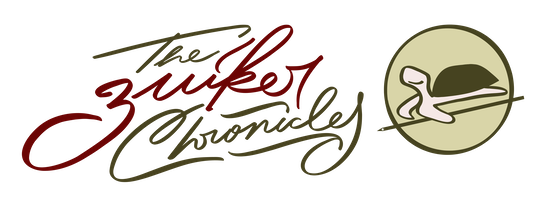Read the heat
by Anton Zuiker on October 13, 2024
The weekend’s autumn weather was perfect, with sunny days and cool nights. Erin is still getting through Covid, so we had no social activities. After Oliver’s soccer game in Durham Friday afternoon—he was at right center back and he defended well in the j.v. team’s lopsided win—I snuck out for music at Cat’s Cradle Back Room.
Saturday was glorious and I had time on my hands. I took a cup of coffee and a book to the back deck and sat in one of the modern Adirondack chairs that my brother Matt had given us for a housewarming gift last year. The book was a new teen and young-adult novel by Michael Ruhlman: If You Can’t Take the Heat. It’s a story about an injured high school athlete in the suburbs of Cleveland in 1980. Young Theo Claverback meets a girl, he gets a job in the kitchen of a good restaurant, and he learns a few life lessons and cooking habits.

I loved this book!
I spent most of the day reading it, only taking breaks to refill my coffee and to put the legs on a bench I’ve been making from a slab of the white oak that came from the trees we milled in 2019. I had a ticket to another show at Cat’s Cradle but I read right up to show time, finishing the last page and then taking a quick shower and pulling on my boots.
During the lull between opening act (Dori Freeman) and headliner (The Wildmans), I thought about what I liked so much about Ruhlman’s story: its narrator’s voice made the story flow well, the kitchen scenes were more expansive and realistic than the enjoyable but frenetic scenes from The Bear, and all of those Cleveland references reminded me of my decade or so in Cleveland.
For example, the Shaker Lakes are a key location in the story and I first kissed Erin on a bench at the Shaker Lakes. Also, the restaurant where Theo gets to work is in a house on Larchmere Boulevard, and Erin and I lived for a year after Peace Corps seven buildings over from Larchmere. And in the Acknowledgements, Michael notes that three of the characters who work in the restaurant have the names of real people who worked with Michael in Sans Souci, a great restaurant that was in downtown Cleveland for the longest time. Erin and I were invited to attend a special dinner to celebrate the Sans Souci fifth anniversary in 1997—I was editor of Northern Ohio LIVE then, and Erin and I were getting ready to depart for Vanuatu—and I remember that Michael was working in the kitchen that night and we chatted on our way out.
Now that I’m done with If You Can’t Take the Heat, I’m hoping Erin and Oliver will read it soon. Oliver surprised me this week, opting to keep his gaming computer off so he could read to the end of Between the World and Me, a book he voluntarily chose for his English assignment. Oliver and his friends have started to cook together, so I suspect he’ll thoroughly enjoy the Ruhlman story, too.
In all my forms, everywhere
by Anton Zuiker on October 13, 2024
Dave celebrated 30 years as a blogger, and he’s having a blast developing a new textcasting tool that connects WordPress and Mastodon and someday, perchance, the rest of the web of social media and Fediverse tools. Meanwhile, Manton has added Threads crossposting to Micro.blog.
I feel myself hesitating at this rapid interconnectedness. I’ll be slow to adopt this. I’ll not rush to be posting across Bluesky and Mastodon and Threads and other services. I’m still scarred from my online wipeout 10 years ago.
But as I’ve been watching Dave’s excitement and following the community discussion across Micro.blog, I’ve been thinking about Robin Sloan’s latest novel, Moonbound. In that, Sloan has imagined a delightful character named Clovis, a wandering robot that is wirelessly connected to other traveling robots in the world. Indeed, the robots share the same consciousness.
When the sun was high in the sky, Ariel found himself gaining on a robot grinding slowly along the Rath-road. Unlike Clovis, this robot was squat, barrel-shaped, and rolling on treads.
As he passed, the robot buzzed: “Hello, Ariel de la Sauvage.”
He looked at the rotund robot. “We have not met,” said Ariel. “How do you know my name …?”
“I have met you,” the robot said. “I am Clovis. In all my forms, everywhere, I am Clovis.”
“Where is the form I met?”
“I am walking to the coast. I am nearly there.”
Clovis was my favorite character in the novel. (Read it and enjoy.)
A lot of my early blogging, in the years 2000 to 2004, documented my own excitement at all the writing and publishing and discussion tools that were becoming available. I bounced from one to another but, in the summer of 2004, I settled on Textpattern. I’ve been using this for my main blog (Zuiker Chronicles, then mistersugar.com, then back to Zuiker.com) for 20 years now and I’m grateful to Team Textpattern for their steady development and ongoing stewardship of the CMS.
What’s cool about the textcasting and crossposting that Dave and Manton and others are building is that I can stay with Textpattern for my main blog and push my writing, if and when I’m ready, to a wider net. I do remember now that I am already crossposting to Mastodon (.@mistersugar@opalstack.social).
I will need to decide if, “in all my forms,” I will be mistersugar or antonzuiker—I am my name and I still love my nickname, but I stopped using mistersugar (explained here) during my social media sabbatical, and I’ve wanted to go back.
Kava in Durham
by Anton Zuiker on October 10, 2024
This is a short post only to point to a longer post over on Wan Smol Blog. I knew I wanted to raise a toast to Mereva Timante as she is getting married in Vanuatu. Today though I was monitoring a discussion in Micro.blog about the merits of that excellent system—which I use for Wan Smol Blog—and so I decided to write the post in that tonight. (Thanks to Manton for his great work in developing Micro.blog.)
Scripting News at 30
by Anton Zuiker on October 7, 2024
Dave Winer is celebrating 30 years of blogging at Scripting News.
Everything I wrote five years ago is still true: Dave’s posts, his podcasts, his new tools, his links, his essays, and his drumbeat of requests—textcasting and making news organizations accountable to the citizens—are my daily dose of internet medicine.
I’m still reading Scripting News every day, testing and using Dave’s writing and reading tools, and finding inspiration in the ideas Dave is developing and the questions he is asking.
Some of the ways:
- I helped test Drummer as Dave was developing this excellent blogging tool, and I’ve used it to blog at Yumi stap storian.
- I use Feedland to read RSS feeds from all over and to manage the Duke River of News, as well as to keep a linklog (see the links tab on storian).
So, once again, a heartfelt “Congratulations, Dave, and thank you!”
Prairie pride
by Anton Zuiker on October 6, 2024

The Allen Family farmhouse and prairie strip.
In the NYTimes, this article (gift link, so read it free) highlights the growth in replanted pieces of farmland across the middle of the United States.
The restored swaths of land are called prairie strips, and they are part of a growing movement to reduce the environmental harms of farming and help draw down greenhouse gas emissions, while giving fauna a much-needed boost and helping to restore the land.
Last month, when I visited Illinois, I spent an afternoon with my Aunt Ginger and Uncle Stoddard at their farm in Cortland. Stoddard, my cousin Tom, and I walked outside for an hour, talking about the chicken coop and pigeon roost, the concord grapes, the black walnut and other trees Stoddard has planted over 50 years, and the strip of wildflowers and native grasses that he put between the house and the corn field to the east. You can clearly see Stoddard’s prairie strip in the satellite image above.
As he identified the cone flowers and bluestem grass, pointed to a butterfly that landed nearby, and demonstrated how to crush a seedpod and scatter seeds, he was visibly proud of this strip of life. I knew he would be—he’s been teaching me about flowers and trees for more than half my life. In 2002, I wrote this on my blog:
Back on the highway, I frequently tried to snap pictures of the swatches of wildflower color that burst into my vision as I sped along. The red poppies were my favorite, but the fields of yellow or purple or white were pleasant, too. These wildflowers reminded me of my Uncle Stoddard Allen, who loves to plant flowers and trees. When I worked with him on the farm 10 years ago, my favorite task was to sprinkle wildflower seeds among the fields of prairie grass. Uncle Stoddard, the husband of my mother’s sister, Ginger, is the one who arrested Uncle John Zuiker when he chained himself to a condemned tree at Northern Illinois University, where Stoddard was a policeman. Uncle John these days takes care of trees for Fairfax County in Virginia.
Stoddard is still inspiring me. (Uncle John is retired from the tree work, but he’s the one who was in Raleigh last week for bluegrass.) Behind my own house, in view from the bedroom window, is my own patch of wildflowers, planted with seed from Garrett Wildflower Seed Farm (a North Carolina company). This week, I’ll be working on a strip of land for yellow Indiangrass.
In another sign of the times, the field to north of the Allen house, land once owned by Stoddard’s parents, is now a solar farm (look again at that photo above).

